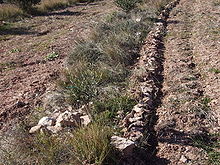- Contour plowing
-
Contour plowing (or contour ploughing) or contour farming is the farming practice of plowing across a slope following its elevation contour lines. The rows formed slow water run-off during rainstorms to prevent soil erosion and allow the water time to settle into the soil. In contour plowing, the ruts made by the plow run perpendicular rather than parallel to slopes, generally resulting in furrows that curve around the land and are level. A similar practice is contour bunding where stones are placed around the contours of slopes.
Contents
History
The Phoenicians first developed the practice of contour farming and spread it throughout the Mediterranean. However, the Romans preferred cultivation in straight furrows and this practice became standard in Europe and Britain.
Modern history
This was one of the main procedures promoted by the U.S. Soil Conservation Service (the current Natural Resources Conservation Service) during the 1930s. The U.S. Department of Agriculture established the Soil Conservation Service in 1935 during the dust bowl when it became apparent that soil erosion was a huge problem.
The extent of the problem was such that the 1934 "Yearbook of Agriculture" noted that Approximately 35 million acres [142,000 km²] of formerly cultivated land have essentially been destroyed for crop production. . . . 100 million acres [405,000 km²] now in crops have lost all or most of the topsoil; 125 million acres [506,000 km²] of land now in crops are rapidly losing topsoil.
The Soil Conservation Service worked with state governments and universities with established agriculture programs such as the University of Nebraska to promote the method to farmers. By 1938, the introduction of new agricultural techniques such as contour plowing had reduced the loss of soil by 65 % despite the continuation of the drought
Demonstrations showed that contour farming, under ideal conditions, will increase yields of row crops by up to 50%, with increases of between 5 and 10% being common. Importantly, the technique also significantly reduces soil erosion.
Contour plowing is also promoted in countries with similar rainfall patterns to the United States such as western Canada and Australia.
The practice is effective only on slopes with between 2% and 10% gradient and when rainfall does not exceed a certain amount within a certain period. On steeper slopes and areas with greater rainfall, a procedure known as strip cropping is used with contour farming to provide additional protection.[1]
P. A. Yeomans' Keyline Design system is critical of traditional contour plowing techniques, and improves the system through observing normal land form and topography. At one end of a contour the slope of the land will always be steeper than at the other. Thus when plowing parallel runs paralleling any contour the plow furrows soon deviate from a true contour. Rain water in these furrows will thus flow sideways along the falling "contour" line. This can often concentrate water in a ways that exacerbates erosion instead of reducing it. Yeomans was the first to appreciate the significance of this phenomenon. Keyline cultivation utilizes this "off contour" drift in cultivating furrows to control the movement of rain water for the benefit of the land. ( See Chapter 7 in Priority One History of Twentieth Century Soil Conservation and Keyline.)
Contour bunding has been widely adopted in Burkina Faso after it was suggested by British Oxfam worker Bill Hereford in the beginning of the 1980s.
See also
References
External links
- NRCS Conservation Practice Standard 330-Contour Farming 4 page pdf file
- American Experience page on the dust bowl
- Encyclopaedia Britannica page on contour farming
- Purdue University article on contour farming
- Natural Resources Conservation Service page on sustainable farming
- Manitoba Soil Conservation Resource Manual
- Priority One. Together We Can Beat Global Warming
- Pearce, F. (2002) Africans go back to the land as plants reclaim the desert, New Scientist 21. September, page 4.
- Looking after our land - Soil and Water Conservation in Dryland Africa - Detailed instructions for contour bund construction.
- BBC News - Sahara desert frontiers turn green
Categories:
Wikimedia Foundation. 2010.


